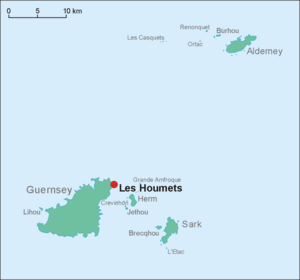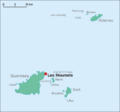Houmets facts for kids
Les Houmets are a group of small islands, also called islets, located to the east of Guernsey in the Channel Islands. Their name comes from the Norman language word "hou," which means islet. These islands are tidal islands, meaning they are connected to the mainland or other islands by a strip of land at low tide, but become separate islands when the tide is high.
Some of the main islets in this group include Houmet Benest (sometimes called Houmet Benêt), Houmet Paradis, and Houmet Hommetol (often known as Omptolle).
The famous writer Victor Hugo once suggested that these islets were heavily changed by quarrying (digging for stone). However, another writer named Victor Coysh disagreed. Coysh pointed out that old maps show Les Houmets have been separate islands for a very long time. He believed that quarrying didn't significantly change the coast where these islets are located.
Contents
Victor Hugo's Story
Victor Hugo, a famous French writer, wrote about many of the Channel Islands in his books. He described Les Houmets in his novel Toilers of the Sea (originally titled Les Travailleurs de la mer). In the story, the main character, Gilliat, lives on Houmet Paradis.
Hugo described Gilliat's house, called the Bû de la Rue, as being on a rocky point that created a small, separate harbor. The water there was very deep. The house was quite isolated, almost off the land, with just a small garden. Sometimes, high tides would flood the garden.
The novel also tells a mysterious story about the house before Gilliat lived there. Local people believed the Bû de la Rue was haunted. For over 30 years, no one had lived in it, and it was falling apart. The garden, often covered by the sea, couldn't grow anything. People said that if you left a ball of yarn, needles, and a plate of soup on the mantelpiece at night, you would find the soup gone and a pair of mittens knitted by morning!
The house, even with its supposed ghost, was sold for a very low price. A woman, not from France, bought it and moved in with her child. From that moment, the haunting stopped, and peace returned to the house.
However, today you won't find Gilliat's house or the cove of Houmet Paradis as described in the book. Victor Hugo wrote that the small peninsula where the house stood was completely dug up and its rocks were taken away, cartload by cartload. Much of this rock was even taken to London. The novel was written in the 1860s but was set in the 1820s, a time when these islands were still inhabited.
The Islets of Les Houmets
Each of the islets in Les Houmets has its own unique history and features.
Houmet Benest
Houmet Benest, also known as Houmet Benêt, is about 180 meters (200 yards) from the shore. It's shaped like a triangle and measures about 73 by 45 meters (80 by 50 yards). In the 1700s, a gun battery was built here to defend against the French. Later, during World War II, the German forces added their own defenses, and the British built another one after the Germans left.
This islet has also been the site of several shipwrecks. In 1921, the steamer Clarrie sank near Houmet Benêt. In 1952, another ship called Heathery Brae tried to salvage the Clarrie but ended up getting wrecked itself. Other ships that went ashore here include the brig Vixen, the tugboat Rescue, and the cutter Romp. Today, Houmet Benest is covered in grass and thorny bushes called brambles.
Houmet Paradis
Houmet Paradis is the islet where Victor Hugo's fictional character, Gilliat, lived. It was originally called Houmet de l'Eperquerie. This name came from its use for cleaning fish and drying them on stands called perques (which means perches).
The islet used to belong to the Collas family, whose nearby estate was called Paradis, giving the islet its new name. In the 1920s, Houmet Paradis was used for quarrying stone. It was also used for grazing cattle and has a lot of grass.
In 1951, a man named James Watson bought the island for £500. He placed it under the care of the National Trust of Guernsey, an organization that protects important natural and historical sites. The island stayed in his family until 2004. Then, James Watson's grandson (also named James Watson) sold it at an auction to a local group. This group bought the island to keep it as a nature reserve, protecting its natural environment.
Hommetol (Omptolle)
Hommetol, more commonly called Omptolle, is another islet in the group. People often visit this islet to gather ormers, which are a type of large sea snail that lives in shells. The islet is mostly covered in a plant called thrift, which is a small, tough plant that grows well in coastal areas.
Images for kids



